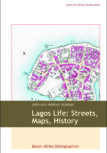Lagos Life: Streets, Maps, History
Lagos Life: Streets, Maps, History
Urban questions have taken on a new urgency in Africa, as cities like Lagos continue to grow faster and more intensely, seemingly every day. Most often, engagement with these cities is framed in terms of their problems: too crowded, too disorganized, too frenetic. But how should we understand the ways the past shaped and produced this present? “Lagos Life” explores the histories of Lagos’s streets as markers of the moments of placemaking, identity, freedom, and displacement in the nineteenth century. It begins with the premise that Lagos’s streets offer important clues and cues to the ways to ask, analyze and frame the historical and contemporary narratives of the city.
Much like the ways that court transcripts and letters can be read and analyzed to yield insights about the past, street names in Lagos bear witness to the ways that the city’s pasts intertwine. In 1868, an English-speaking Yorùbá court clerk named all the newly paved streets in Lagos, in the wake of new colonial infrastructure that was quickly taking root. Rather than superimposing British names or even a stripped-down numbering scheme, the mostly indigenous Yorùbá names he chose reflect a remarkable archive of local priorities, symbols, events, places, and people. By mapping the history of these streets, and the encounters that Lagosians had in them, this presentation demonstrates how digital tools can be deployed in reading the urban fabric of Lagos Island as an archive of its own history.
Trained as both historian and computer engineer, Ademide Adelusi-Adeluyi’s research into the history of Lagos, Nigeria combines a set of interdisciplinary interests in urban studies, mapmaking and technology. She is an Associate Professor of History at Howard University, and she received her PhD in History from NYU in 2016.

